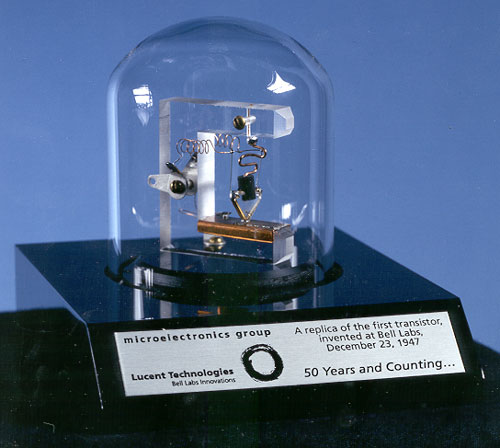Glance to 1st Transistor
A transistor is the most important component that any chip has! Have you really thought of how the first transistor was invented? Have you ever wondered how the modern world would be without transistors? The need for the transistor had its origins in the growing need for a more compact, efficient, and reliable alternative to the vacuum tube technology that dominated electronics in the mid-20th century. But how did the first transistor come to be?

Source: Wikipedia
The development of the first transistor was a major breakthrough in the history of electronics. It was invented in 1947 by John Bardeen, Walter Brattain, and William Shockley at Bell Labs.
In certain respects, there was a fourth person was responsible for the transistor being discovered at that time. Marvin Kelley, who was the head of Bell Laboratories, had brought the trio together. Kelley believed that working with such an unknown group of materials as semiconductors demanded a combination of different specialties: the brilliant theorist Brattain, the skilled materials expert Bardeen, and the very accomplished experimentalist Shockley, who also had a strong hand in theories.
Bardeen, Brattain, and Shockley were working on a way to replace vacuum tubes in electronic devices. Vacuum tubes were bulky, unreliable, and consumed a lot of power. Transistors, on the other hand, were small, reliable, and efficient.
The first transistor was a point-contact transistor, which was made by pressing two metal contacts onto a germanium crystal. The metal contacts acted as electrodes, and they allowed current to flow through the germanium crystal in a controlled way.
The point-contact transistor was a major breakthrough, but it was not very reliable. It was also difficult to manufacture.
The first transistor has the following features:
- It was made of germanium.
- It had two metal contacts that were pressed onto the germanium crystal.
- The contacts acted as electrodes, and they allowed current to flow through the germanium crystal in a controlled way.
- The transistor was small, but it was not very reliable.
- It was also difficult to manufacture.
In 1950, Shockley invented the junction transistor. Junction transistors are more reliable and easier to manufacture than point-contact transistors. They were also more versatile, and they could be used in a wider range of electronic devices. Junction transistors quickly replaced point-contact transistors, and they became the standard transistor for many years.
Conclusion
The invention of the transistor revolutionized electronics, leading to the development of smaller, more reliable, and energy-efficient electronic devices. It played a crucial role in the miniaturization of electronics, the creation of the semiconductor industry, and the eventual development of integrated circuits. The transistor’s impact on technology and society cannot be overstated, as it laid the foundation for the modern information age.
Semiconductor Industry